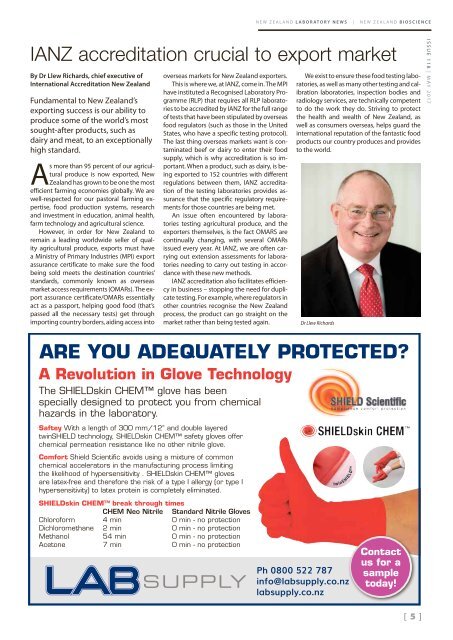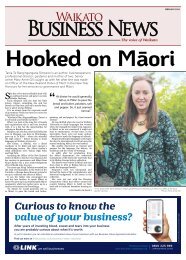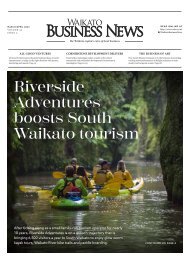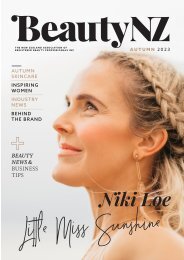Laboratory News & BioScience May 2017
New Zealand's leading scientific publication for more than 20 years. This bi-monthly magazine provides the latest up to date information on new products and services to a readership which is carefully targeted and updated on a regular basis.
New Zealand's leading scientific publication for more than 20 years. This bi-monthly magazine provides the latest up to date information on new products and services to a readership which is carefully targeted and updated on a regular basis.
- No tags were found...
You also want an ePaper? Increase the reach of your titles
YUMPU automatically turns print PDFs into web optimized ePapers that Google loves.
NEW ZEALAND LABORATORY NEWS | NEW ZEALAND BIOSCIENCE<br />
IANZ accreditation crucial to export market<br />
By Dr Llew Richards, chief executive of<br />
International Accreditation New Zealand<br />
Fundamental to New Zealand’s<br />
exporting success is our ability to<br />
produce some of the world’s most<br />
sought-after products, such as<br />
dairy and meat, to an exceptionally<br />
high standard.<br />
As more than 95 percent of our agricultural<br />
produce is now exported, New<br />
Zealand has grown to be one the most<br />
efficient farming economies globally. We are<br />
well-respected for our pastoral farming expertise,<br />
food production systems, research<br />
and investment in education, animal health,<br />
farm technology and agricultural science.<br />
However, in order for New Zealand to<br />
remain a leading worldwide seller of quality<br />
agricultural produce, exports must have<br />
a Ministry of Primary Industries (MPI) export<br />
assurance certificate to make sure the food<br />
being sold meets the destination countries’<br />
standards, commonly known as overseas<br />
market access requirements (OMARs). The export<br />
assurance certificate/OMARs essentially<br />
act as a passport, helping good food (that’s<br />
passed all the necessary tests) get through<br />
importing country borders, aiding access into<br />
overseas markets for New Zealand exporters.<br />
This is where we, at IANZ, come in. The MPI<br />
have instituted a Recognised <strong>Laboratory</strong> Programme<br />
(RLP) that requires all RLP laboratories<br />
to be accredited by IANZ for the full range<br />
of tests that have been stipulated by overseas<br />
food regulators (such as those in the United<br />
States, who have a specific testing protocol).<br />
The last thing overseas markets want is contaminated<br />
beef or dairy to enter their food<br />
supply, which is why accreditation is so important.<br />
When a product, such as dairy, is being<br />
exported to 152 countries with different<br />
We exist to ensure these food testing laboratories,<br />
as well as many other testing and calibration<br />
laboratories, inspection bodies and<br />
radiology services, are technically competent<br />
to do the work they do. Striving to protect<br />
the health and wealth of New Zealand, as<br />
well as consumers overseas, helps guard the<br />
international reputation of the fantastic food<br />
products our country produces and provides<br />
to the world.<br />
Being compliant with the standards does not guarantee a<br />
because what is tested relates to the materials used, metho<br />
length and thickness of the glove, etc. In the table below you<br />
mance for three of our synthetic gloves based on EN16523-1:2<br />
all comply with the same standards, but as you will notice th<br />
same level of performance.<br />
regulations between them, IANZ accreditation<br />
of the testing laboratories provides THE assurance<br />
that the specific regulatory require-<br />
THICKER AND LONGER THE GLOVE, THE BETT<br />
Chemical name CAS n° Concentration<br />
ments for those countries are being met.<br />
SHIELD<br />
NEO N<br />
An issue often encountered by labora-<br />
Thickness (Palm) 0<br />
tories testing agricultural produce, and the<br />
Sodium acetate Sat. solution 127-09-3 100% 4<br />
exporters themselves, is the fact OMARS are<br />
Acetic Acid 64-19-7 100%<br />
continually changing, with several OMARs<br />
issued every year. At IANZ, we are often Hydrochloric carrying<br />
Acid 7647-01-0 37% 4<br />
out extension assessments for labora-<br />
Formic Acid<br />
tories needing to carry out testing in Acrylamide accordance<br />
64-18-6<br />
79-06-1<br />
98-100%<br />
40%<br />
1<br />
4<br />
with these new methods. Secondary isoarmyl alcohol 98% 598-75-4 100% 4<br />
IANZ accreditation also facilitates efficiency<br />
in business – stopping the need for dupli-<br />
Ethidium Bromide 1239-45 5% 4<br />
Chloroform 67-66-3 99,80%<br />
cate testing. For example, where regulators in<br />
Dimethyl Formamide (DMF) 68-12-2 99%<br />
other countries recognise the New Zealand<br />
process, the product can go straight Dimethyl on the Sulfoxide (DMSO) 67-68-5 99% 1<br />
market rather than being tested again. Ethanol Dr Llew Richards<br />
64-17-5 100% 1<br />
Formaldehyde 50-0-07 37% 4<br />
Formamide 75-12-7 100% 1<br />
Isobutanol 78-83-1 100% 4<br />
Isopropanol 67-63-0 100% 4<br />
Methanol 67-56-1 99,90%<br />
Phenol 108-95-2 50% 1<br />
Sodium Hydroxide 1310-73-2 50% 4<br />
Thris (hydroxymethyl)<br />
aminomethane Sat. solution<br />
ISSUE 118 | MAY <strong>2017</strong><br />
77-86-1 100% 4<br />
DISCLAIMER: The data provided was based on gloves tested under laborato<br />
information is for guidance only and may not reflect the user’s application. A<br />
assess the suitability of gloves for a specific application.<br />
+<br />
twinSHIELD<br />
twinSHIELD techn<br />
• Double-layered = reduced<br />
• Stronger = better protecti<br />
• 2 colours: Red, Orange or<br />
ding to the risk and a soft<br />
EN16523-1: 2015 (s<br />
• Breakthrough occurs whe<br />
• The test temperature is 2<br />
• Test results must be with<br />
samples tested. The lowe<br />
PPE CAT. III<br />
AQL<br />
0,65<br />
0120<br />
[ 5 ]


















